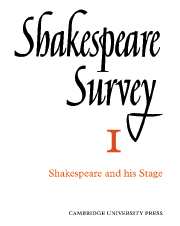Book contents
- Frontmatter
- Studies in the Elizabethan Stage since 1900
- Titus Andronicus on the Stage in 1595
- A Note on the Swan Theatre Drawing
- The Bankside Theatres: Early Engravings
- Shakespeare and the Blackfriars Theatre
- Shakespeare’s Bad Poetry
- The Folger Shakespeare Library
- The Heritage of Shakespeare’s Birthplace
- Three Shakespearian Productions: A Conversation
- Four Lears
- London Productions
- Stratford Productions
- International News
- The Year's Contributions to Shakespearian Study 1 Critical Studies
- 2 Shakespeare’s Life and Times
- 3 Textual Studies
- Books Received
- Index
- Plate section
A Note on the Swan Theatre Drawing
Published online by Cambridge University Press: 28 March 2007
- Frontmatter
- Studies in the Elizabethan Stage since 1900
- Titus Andronicus on the Stage in 1595
- A Note on the Swan Theatre Drawing
- The Bankside Theatres: Early Engravings
- Shakespeare and the Blackfriars Theatre
- Shakespeare’s Bad Poetry
- The Folger Shakespeare Library
- The Heritage of Shakespeare’s Birthplace
- Three Shakespearian Productions: A Conversation
- Four Lears
- London Productions
- Stratford Productions
- International News
- The Year's Contributions to Shakespearian Study 1 Critical Studies
- 2 Shakespeare’s Life and Times
- 3 Textual Studies
- Books Received
- Index
- Plate section
Summary
So familiar to all is the drawing of the Swan Theatre that it might seem as though no good purpose could be served by reproducing it once more in this volume. Full justification for its appearance here is, however, to be found in three rather surprising facts. First, most of the existing reproductions either have been taken from inadequate copies of the original or else have been rendered by line-block, thus partly destroying the quality of the drawing itself. Second, hardly ever is the reproduction of the sketch accompanied by the explanatory commentary to which it is attached. And, third, not one of the theatre histories which quote this commentary has given an impeccable transcription of the original. For these reasons it seems that those interested in the Elizabethan stage may find it convenient to have the Swan Theatre drawing and the relevant text reproduced directly from photographs made especially for this purpose.
The facts concerning the document in which the drawing appears are well enough known and need not be repeated here, but attention may be drawn to a recent article in which fresh biographical information is provided concerning Johannes de Wit or de Witt (who originally sketched the Swan Theatre during a visit to London) and Arend Van Buchel, his friend (who copied the drawing and recorded de Wit's comments upon it). The article presents the texts of numerous extant letters to diverse correspondents written by these two men. The reference is: A. Hulshof and P. S. Breuning, “Brieven van Johannes de Wit aan Arend Van Buchel en anderen” (Bijdragen en mededeelingen, Historisch Genootschap, Utrecht, lx, 1939, 87-208).
- Type
- Chapter
- Information
- Shakespeare Survey , pp. 23 - 24Publisher: Cambridge University PressPrint publication year: 1948

